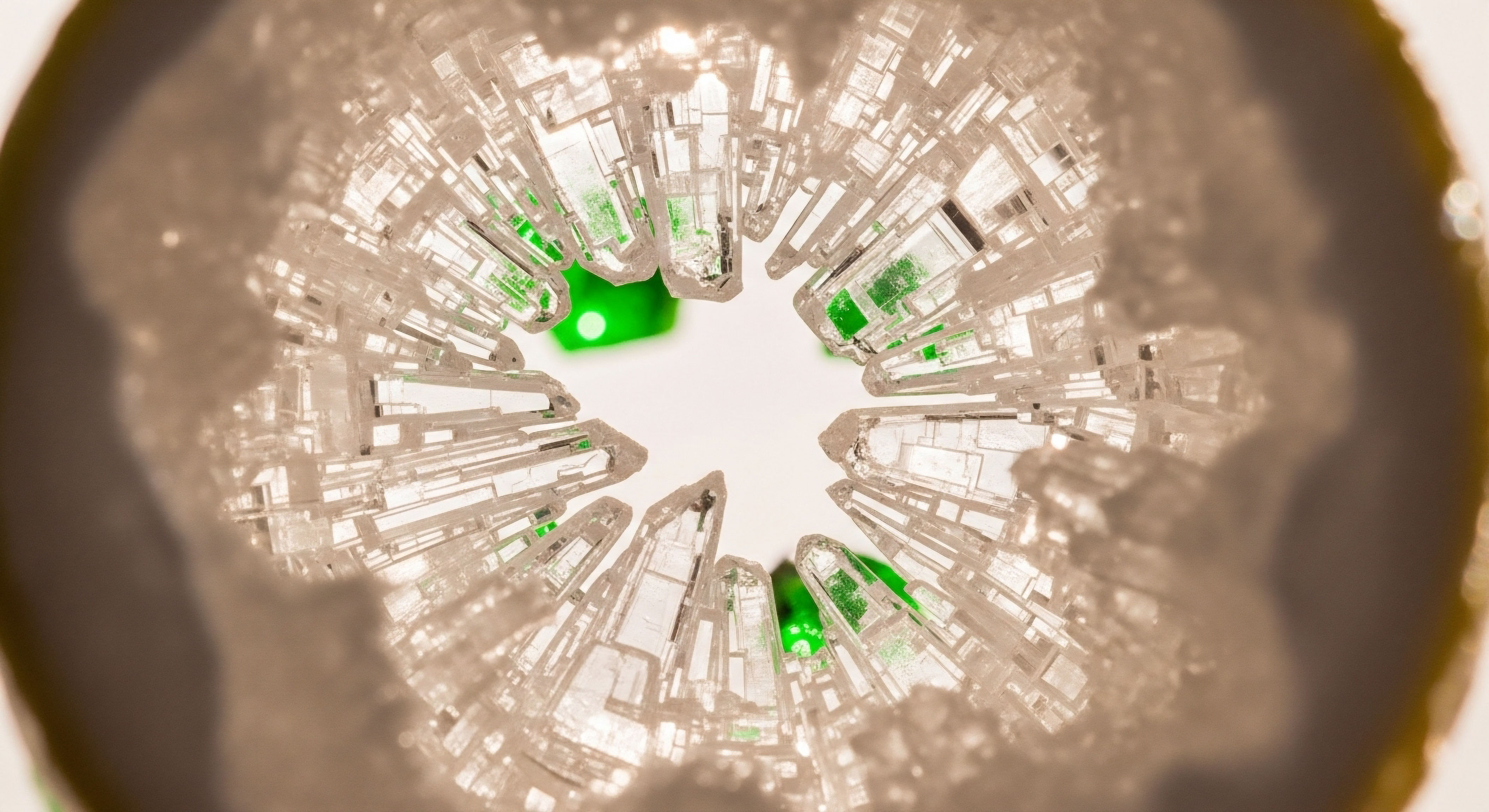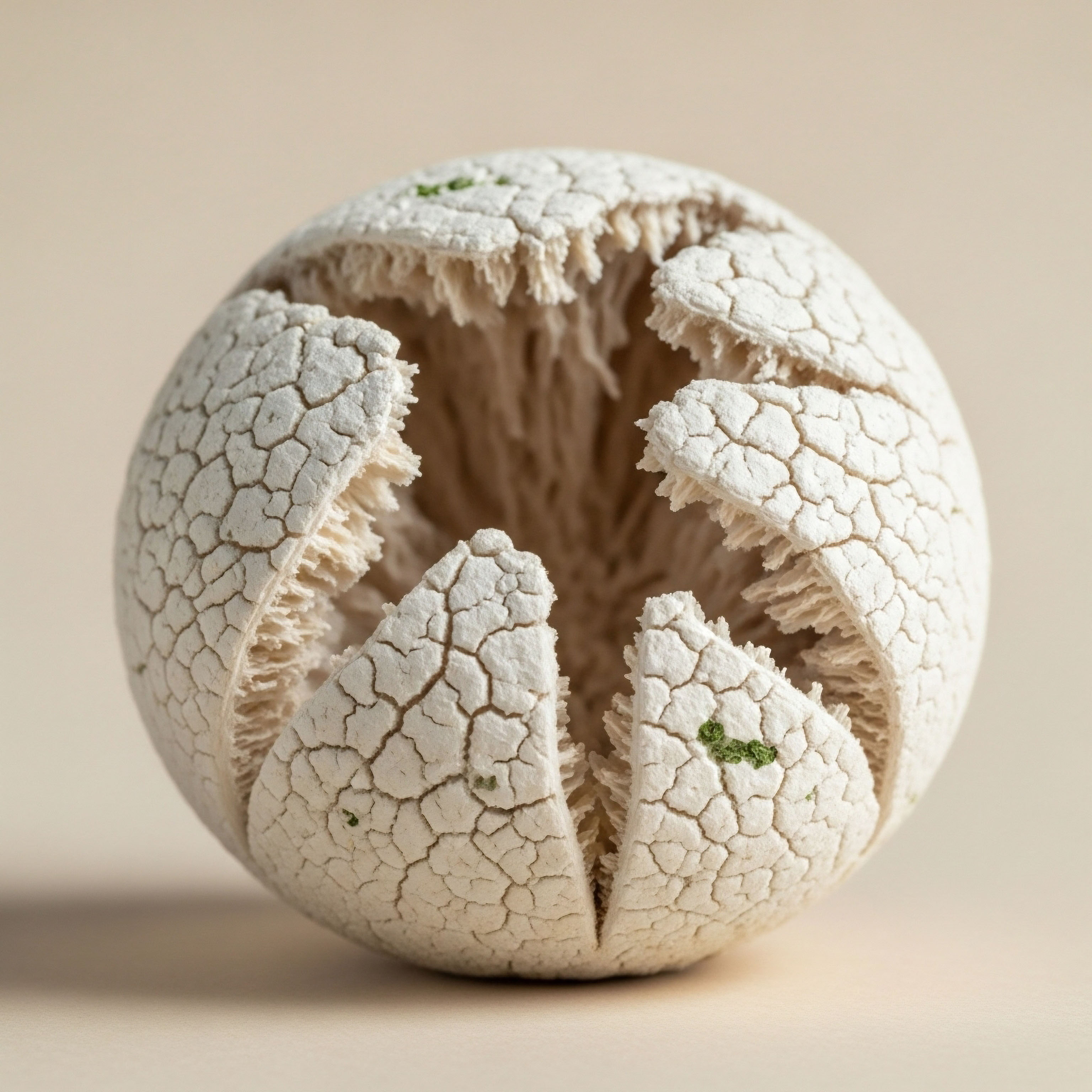

Fundamentals
You feel it in your body ∞ a shift, a change in resilience, a sense that the architecture that supports you is undergoing a quiet transformation. This experience is real, and it is anchored in a continuous, dynamic process within your very bones.
Your skeletal system is a living tissue, constantly being broken down and rebuilt in a sophisticated process called remodeling. This is not a sign of decay; it is a sign of life. It is your body’s way of repairing micro-damage, adapting to mechanical stress, and maintaining mineral balance.
The central question is not whether this process is happening, but who is directing it. The answer lies in the silent, powerful language of hormones, and the profound discovery is that your daily choices are the primary authors of this hormonal conversation.
Think of your bones as a meticulously managed structure. Two specialized cell types are the on-site crew ∞ osteoclasts, which carefully dismantle and remove old bone tissue, and osteoblasts, which diligently build new bone in its place. For your skeletal framework to remain strong, the work of these two crews must be exquisitely balanced.
This balance is maintained by a cast of hormonal directors, each sending specific instructions that can either accelerate building or hasten removal. Your lifestyle choices ∞ what you eat, how you move, the stress you navigate, the sleep you achieve ∞ are what modulate the levels and sensitivity of these hormonal signals. These choices create the biological environment in which your bones either fortify themselves or gradually weaken.
Your skeletal system is a dynamic, living tissue where lifestyle choices directly influence the hormonal signals governing its strength and resilience.

The Primary Hormonal Directors of Bone
Understanding your bone health begins with understanding the key hormonal figures that command the remodeling process. These are not distant, abstract chemicals; they are responsive agents that listen and react to the inputs of your daily life.

Sex Hormones Estrogen and Testosterone
Estrogen and testosterone are fundamental to skeletal integrity in both women and men. Estrogen acts as a powerful brake on the activity of osteoclasts, the cells that break down bone. When estrogen levels are optimal, bone resorption is kept in check, allowing bone-building osteoblasts to keep pace.
In women, the decline of estrogen during perimenopause and menopause removes this protective brake, leading to accelerated bone loss. In men, testosterone contributes directly to bone health, and it is also converted into estrogen, providing a dual layer of skeletal protection. A deficiency in testosterone, therefore, disrupts this system, increasing a man’s vulnerability to bone density reduction.

The Calcium Regulators PTH and Calcitonin
Your body requires a stable supply of calcium in the bloodstream for critical functions like muscle contraction and nerve signaling. The parathyroid hormone (PTH) and calcitonin are the primary regulators of this mineral balance. If blood calcium levels drop, the parathyroid glands release PTH.
PTH signals the bones to release calcium into the blood, a process that involves stimulating osteoclast activity. It also helps the kidneys conserve calcium and activates vitamin D to enhance calcium absorption from your diet. Conversely, calcitonin is released when blood calcium is high, and it works by inhibiting osteoclasts to temper bone resorption.
Your dietary intake of calcium and vitamin D directly informs the activity of these hormones, determining whether your bones must act as a mineral reservoir to be depleted or can remain a fortified structure.

The Stress Factor Cortisol
Cortisol, often known as the primary stress hormone, plays a necessary role in managing energy and inflammation. When chronically elevated due to sustained psychological stress, poor sleep, or metabolic dysfunction, cortisol becomes profoundly disruptive to bone health. High levels of cortisol directly suppress the function and formation of bone-building osteoblasts.
At the same time, it enhances the survival and activity of bone-resorbing osteoclasts. This dual assault tips the remodeling balance decisively toward net bone loss. Chronic stress, therefore, is not just an emotional state; it is a physiological condition that directly undermines the structural integrity of your skeleton.


Intermediate
Recognizing that lifestyle choices influence hormonal signals is the first step. The next is to understand the specific, actionable mechanisms through which this influence is exerted. The decisions you make about movement, nutrition, and recovery are not passive inputs; they are direct commands that can either support a robust hormonal environment for bone health or contribute to its decline.
This is where you translate foundational knowledge into a personalized wellness protocol, leveraging your daily habits to optimize the hormonal regulators of your skeletal system.
This deeper understanding moves from the ‘what’ to the ‘how’. How, precisely, does a session of resistance training send a signal to fortify bone? How does a diet deficient in key nutrients instruct the body to draw minerals from its own framework?
Answering these questions allows for a more refined and effective approach to preserving bone density throughout life. It also illuminates the rationale behind clinical protocols like hormonal optimization, which are designed to restore the biochemical environment that lifestyle choices alone may no longer be able to maintain.

The Mechanical Language of Exercise
Physical activity, particularly weight-bearing and resistance exercise, is one of the most potent modulators of bone remodeling. The mechanical stress placed on the skeleton during these activities communicates a clear message ∞ “This structure needs to be stronger.” This message is translated into a cascade of hormonal and cellular responses.
- Mechanical Loading ∞ When muscles pull on bone during resistance exercise, it creates a physical strain that directly stimulates osteoblasts. This stimulation prompts them to increase bone formation, leading to denser, stronger bones over time.
- Hormonal Response ∞ Intense exercise can transiently increase levels of anabolic hormones like testosterone and growth hormone. These hormones further support the activity of osteoblasts, amplifying the bone-building signal initiated by mechanical stress. For women, while the testosterone response is smaller, the mechanical stimulus remains a powerful driver of bone density.
- Energy Availability ∞ The balance between energy intake from your diet and energy expenditure from exercise is a critical factor. Low energy availability, which occurs when dietary intake is insufficient to cover the costs of training and basic bodily functions, can suppress the production of estrogen and testosterone. This condition, often seen in athletes, can negate the positive effects of exercise on bone and lead to significant bone loss. Adequate nutrition is therefore a non-negotiable partner to exercise for skeletal health.
Weight-bearing exercise and sufficient nutritional intake work together to create the optimal hormonal and mechanical environment for building and maintaining strong bones.

How Do Clinical Protocols Support Bone Health?
When lifestyle interventions are insufficient to correct hormonal imbalances, particularly during andropause in men or perimenopause in women, clinical protocols can be used to restore a more favorable environment for bone remodeling. These therapies are designed to replenish the specific hormones that are essential for maintaining skeletal integrity.
For men experiencing the symptoms of low testosterone, Testosterone Replacement Therapy (TRT) can have a direct and positive impact on bone mineral density (BMD). By restoring testosterone to a healthy physiological range, TRT supports bone formation and, through its conversion to estrogen, helps to restrain bone resorption.
Clinical protocols often involve weekly injections of Testosterone Cypionate, sometimes paired with medications like Anastrozole to manage estrogen levels and Gonadorelin to support the body’s own hormonal axis. Studies have shown that long-term TRT can significantly increase BMD in hypogonadal men, particularly in the spine, and maintain it within a healthy range.
For women navigating perimenopause and menopause, the decline in estrogen is a primary driver of bone loss. Hormone therapy, which replenishes estrogen and often includes progesterone, can effectively slow this process. Estrogen therapy directly addresses the increase in osteoclast activity, preserving bone density and reducing fracture risk.
Progesterone also appears to play a role by stimulating osteoblasts, contributing to the bone formation side of the remodeling equation. The addition of low-dose testosterone to a woman’s protocol can further support bone health, along with improving energy and libido.
The following table illustrates how different hormones, whether produced endogenously or supplemented through therapy, influence the key cells involved in bone remodeling.
| Hormone | Effect on Osteoblasts (Bone Formation) | Effect on Osteoclasts (Bone Resorption) | Primary Lifestyle Influence |
|---|---|---|---|
| Estrogen |
Supportive role |
Strongly inhibits activity |
Age, energy availability, body composition |
| Testosterone |
Directly stimulates activity |
Inhibits activity (partly via conversion to estrogen) |
Resistance exercise, sleep, age |
| Parathyroid Hormone (PTH) |
Stimulates (intermittent exposure) |
Stimulates (continuous high levels) |
Dietary calcium and vitamin D intake |
| Cortisol |
Strongly inhibits activity and formation |
Stimulates activity |
Stress management, sleep quality, blood sugar regulation |


Academic
A sophisticated understanding of how lifestyle choices influence bone remodeling requires an examination of the molecular signaling pathways that govern bone cell function. The conversation between hormones and bone cells is not one of simple commands, but of complex, interconnected networks that translate systemic hormonal changes into specific cellular actions.
Lifestyle factors exert their influence by modulating the key molecules within these pathways, thereby altering the genetic expression and behavior of osteoblasts and osteoclasts. Two of the most critical regulatory systems in this process are the RANKL/RANK/OPG axis and the Wnt/β-catenin signaling pathway.

The RANKL/RANK/OPG Axis a Master Regulator of Bone Resorption
The RANKL/RANK/OPG pathway is the principal signaling system controlling the formation, function, and survival of osteoclasts. Understanding this axis is essential to comprehending how hormones like estrogen and cortisol regulate bone resorption.
- RANKL (Receptor Activator of Nuclear Factor Kappa-B Ligand) ∞ This protein is the primary signal that promotes osteoclast formation and activity. It is expressed by osteoblasts and other cells in the bone marrow environment. When RANKL binds to its receptor, RANK, on the surface of osteoclast precursor cells, it triggers a cascade of intracellular signals that drive these cells to mature into active, bone-resorbing osteoclasts.
- OPG (Osteoprotegerin) ∞ Osteoblasts also produce OPG, which acts as a decoy receptor. OPG binds to RANKL and prevents it from interacting with RANK. By doing so, OPG effectively inhibits osteoclast formation and activity. The balance between RANKL and OPG production is therefore the critical determinant of the rate of bone resorption.
Sex hormones exert a profound influence on this balance. Estrogen powerfully suppresses bone resorption by increasing the production of OPG and decreasing the expression of RANKL by osteoblasts. This action shifts the RANKL/OPG ratio in favor of OPG, effectively putting the brakes on osteoclast activity.
The loss of estrogen during menopause removes this crucial signal, leading to an increase in RANKL and a subsequent surge in bone resorption that outpaces bone formation. Chronically elevated cortisol levels, in contrast, appear to increase RANKL expression, further tilting the balance toward bone breakdown.

What Is the Role of Wnt/β-Catenin Signaling in Bone Formation?
While the RANKL axis governs resorption, the Wnt/β-catenin pathway is a central player in promoting bone formation. This pathway is critical for the commitment of mesenchymal stem cells to the osteoblast lineage and for the function of mature osteoblasts.
The process is initiated when Wnt proteins bind to receptors on the surface of pre-osteoblasts. This binding event triggers a signaling cascade that leads to the accumulation of a protein called β-catenin in the cell’s cytoplasm. β-catenin then enters the nucleus and activates genes that are essential for osteoblast differentiation and bone matrix production.
Testosterone has been shown to promote bone formation by positively influencing this pathway. Conversely, high levels of cortisol can inhibit Wnt signaling, which is a key mechanism by which chronic stress suppresses bone formation.
Molecular pathways like the RANKL/OPG axis and Wnt/β-catenin signaling translate the systemic hormonal milieu created by lifestyle choices into direct cellular actions that determine bone mass.

The Clinical Application of Peptide Therapies
Advanced clinical protocols are now exploring the use of peptide therapies to more directly target these cellular and hormonal pathways to support bone repair and growth. Peptides are short chains of amino acids that can act as highly specific signaling molecules. Growth hormone peptide therapies, for instance, are designed to stimulate the body’s own production of growth hormone (GH) from the pituitary gland. Key peptides in this class include:
- Sermorelin, Ipamorelin, CJC-1295 ∞ These are growth hormone-releasing hormone (GHRH) analogs or growth hormone secretagogues. They work by stimulating the pituitary gland to release GH. Increased GH levels lead to higher production of Insulin-like Growth Factor-1 (IGF-1), primarily in the liver. Both GH and IGF-1 are potent anabolic signals that stimulate osteoblast activity and collagen synthesis, directly promoting bone formation. These therapies can be particularly beneficial for adults seeking to improve tissue repair and counteract age-related decline in the growth hormone axis.
The following table provides a high-level comparison of the mechanisms of action for key hormonal and peptide influences on bone, highlighting their primary targets in the remodeling process.
| Therapeutic Agent | Primary Mechanism of Action | Cellular Effect | Net Impact on Bone |
|---|---|---|---|
| Testosterone |
Directly stimulates osteoblasts and influences Wnt signaling; converts to estrogen. |
Increases osteoblast activity; reduces osteoclast activity. |
Increases bone formation and reduces resorption. |
| Estrogen/Progesterone |
Suppresses RANKL and increases OPG (estrogen); may stimulate osteoblasts (progesterone). |
Reduces osteoclast activity; supports osteoblast function. |
Strongly reduces bone resorption; supports formation. |
| Growth Hormone Peptides (e.g. Ipamorelin) |
Stimulate endogenous GH and subsequent IGF-1 production. |
Directly stimulates osteoblast proliferation and matrix synthesis. |
Increases bone formation. |
| Parathyroid Hormone (PTH) Analogs (e.g. Teriparatide) |
Intermittent administration mimics anabolic PTH signaling. |
Potently stimulates osteoblast activity and new bone formation. |
Strongly increases bone formation. |

References
- Prior, Jerilynn C. “Progesterone and Bone ∞ Actions Promoting Bone Health in Women.” Journal of Osteoporosis, vol. 2018, 2018, pp. 1-11.
- Khosla, Sundeep, et al. “Role of Hormones in Bone Remodeling in the Craniofacial Complex ∞ A Review.” Journal of the Korean Association of Oral and Maxillofacial Surgeons, vol. 48, no. 3, 2022, pp. 125-136.
- Shrestha, Sanjaya, et al. “Vitamin D, Calcium, Parathyroid Hormone, and Sex Steroids in Bone Health and Effects of Aging.” Journal of Gerontology and Geriatric Medicine, vol. 6, no. 1, 2020, p. 063.
- Behre, H. M. et al. “Long-Term Effect of Testosterone Therapy on Bone Mineral Density in Hypogonadal Men.” The Journal of Clinical Endocrinology & Metabolism, vol. 82, no. 8, 1997, pp. 2386-2390.
- Snyder, Peter J. et al. “Effect of Testosterone Treatment on Volumetric Bone Density and Strength in Older Men With Low Testosterone ∞ A Controlled Clinical Trial.” JAMA Internal Medicine, vol. 177, no. 4, 2017, pp. 471-479.
- Redondo-Castro, E. et al. “Stress, Glucocorticoids and Bone ∞ A Review From Mammals and Fish.” Frontiers in Endocrinology, vol. 9, 2018, p. 526.
- “Hormonal Regulation of the Positive and Negative Effects of Exercise on Bone.” ResearchGate, uploaded by Nancy I. Williams, 2012.
- “Peptides for Bone Healing Research.” Peptide Sciences, 2024.
- “The parathyroid glands and vitamin D.” Endocrinology ∞ An Integrated Approach, edited by Stephen Nussey and Saffron Whitehead, BIOS Scientific Publishers, 2001.
- Farr, Joshua N. and Sundeep Khosla. “Cellular and Molecular Mechanisms of Bone Remodeling and Age-Related Bone Loss.” Nature Reviews Endocrinology, vol. 19, no. 11, 2023, pp. 655-671.

Reflection
The information presented here offers a map of the intricate biological landscape that governs your skeletal health. It connects the choices you make every day to the deep, cellular processes that determine the strength of your physical foundation. This knowledge is a powerful tool, shifting the perspective from one of passive aging to one of proactive, informed self-stewardship.
Your bones are not static; they are responsive. They are listening to the signals sent by your diet, your movement, your stress levels, and your sleep.
Consider your own daily rhythms. Where are the opportunities to send a stronger signal for fortification? How can you better manage the biological noise of stress that interferes with repair? This exploration is the beginning of a more conscious partnership with your own physiology.
The path to sustained vitality is built upon this understanding, recognizing that your body possesses a profound intelligence. The goal is to align your lifestyle with that intelligence, creating an internal environment where your systems can function optimally. This journey is deeply personal, and the knowledge you have gained is the first, most essential step toward navigating it with confidence and purpose.



